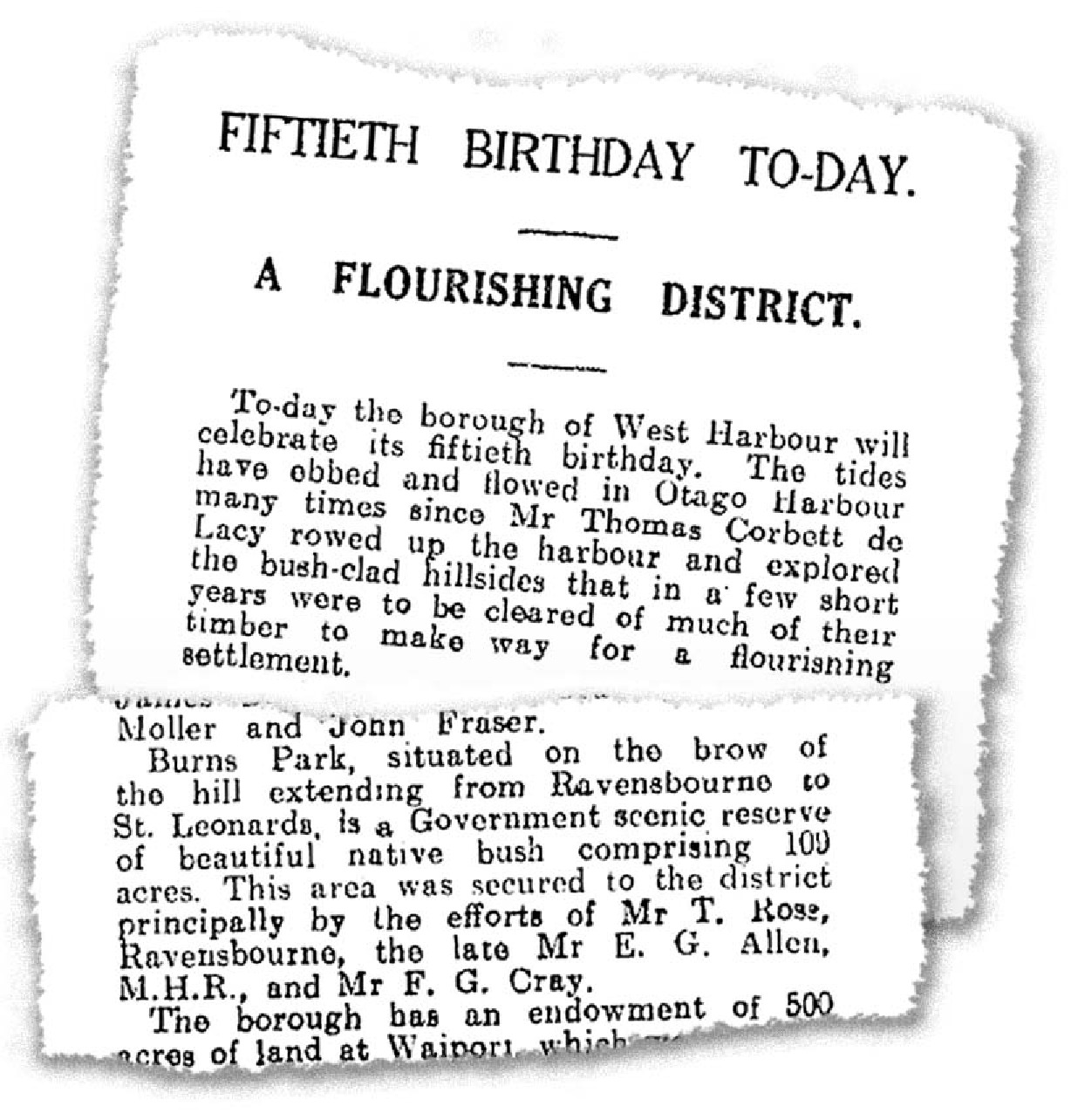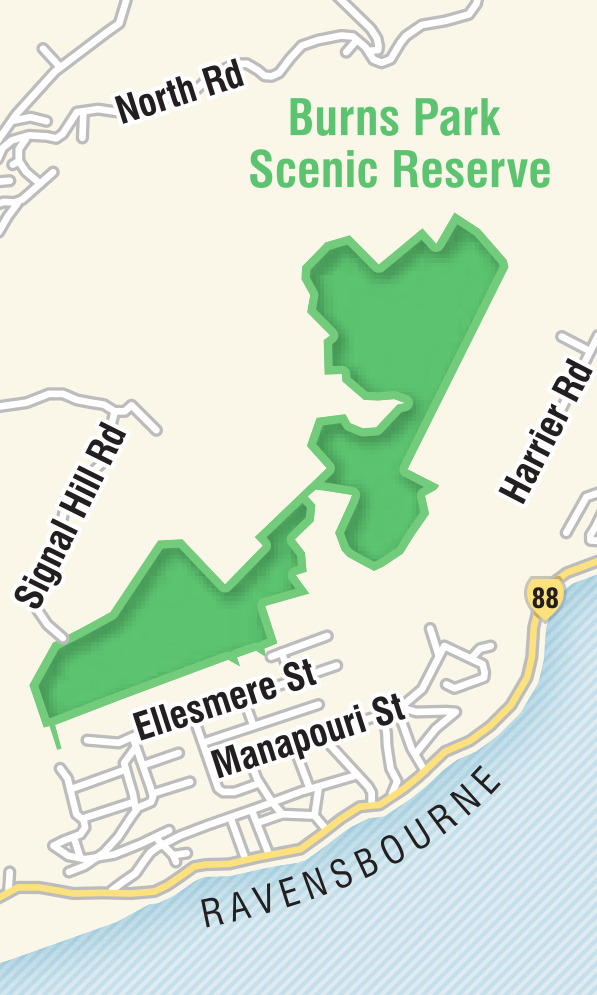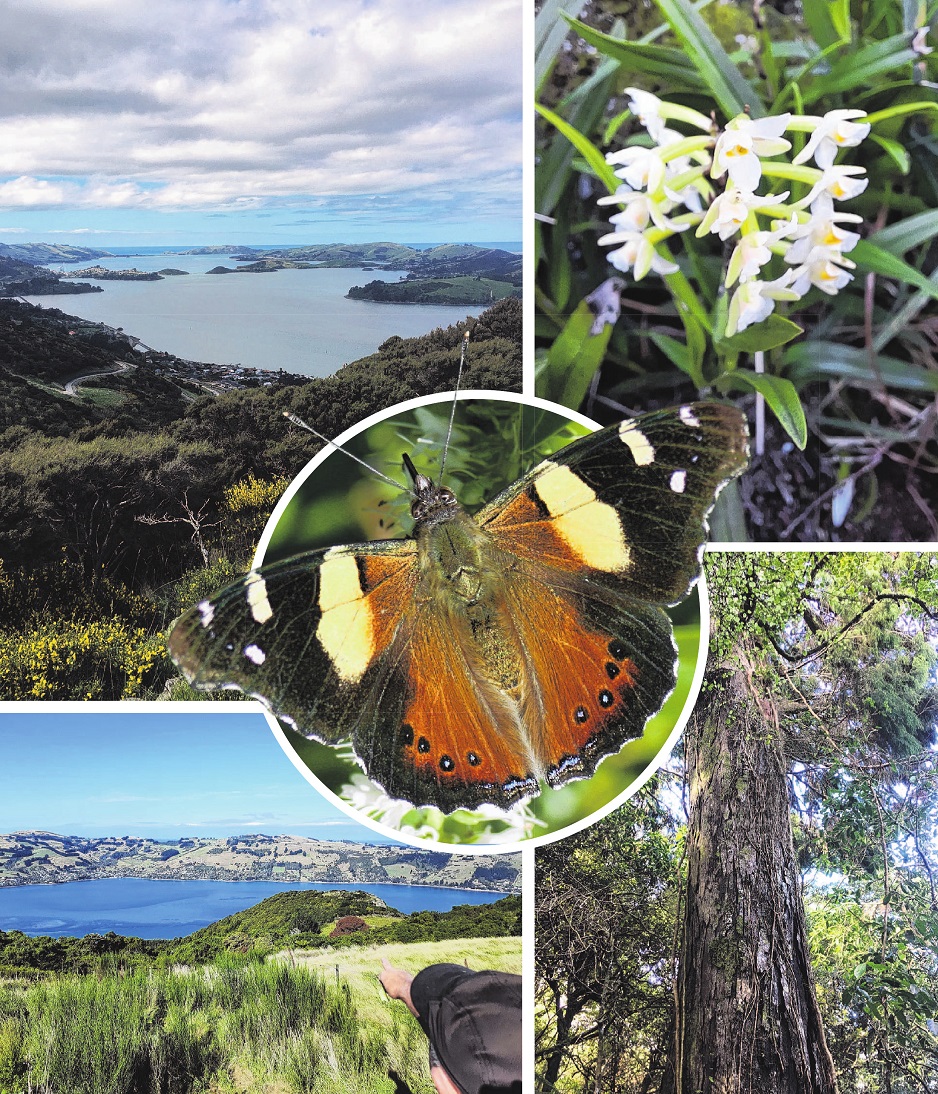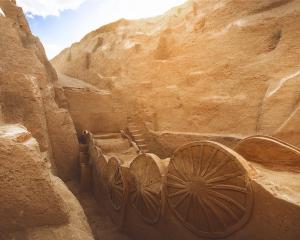
Professor, let alone emeritus professor, was still beyond the line of sight when Jim McQuillan first heard of Burns Reserve.
In 1976, McQuillan had recently returned to his alma mater, the University of Otago, as a chemistry department lecturer, following several years overseas. He and his wife bought a house in the nearby Dunedin hill suburb, Opoho, and, as a keen tramper, he began exploring his backyard — including the hill-line bush below the city’s Centennial Memorial, on the harbour-facing slopes of Signal Hill.
Curious about this native bush and scrub-covered parcel of land, McQuillan’s inquiries were rewarded with a name he had not previously heard, Burns Park Scenic Reserve.
Views of Otago Harbour from Gerry's Rock, Burns Reserve
He took that name to the offices of the about-to-be-dissolved Lands and Survey Department and asked for a map.
"I wanted to know, ‘What is this area? To what extent does it exist?’," McQuillan recalls.
"I was trying to figure out where [Burns Reserve] was and where the boundaries were."
The map McQuillan was given revealed that here, within 4km of the Octagon (as the kereru flies), was a sizeable public reserve that had existed since 1907.
"Its present size, 87 hectares or 216 acres, must make it one of the largest scenic reserves so close to a major New Zealand city and yet almost completely unknown by the Dunedin populace," McQuillan says.
Clearly, it grabbed his attention. And that interest persisted through the decades, despite a long and consuming academic career.
"There were periods when I wasn’t able to think about it or do anything about it."
Since McQuillan retired seven years ago, however, Burns Reserve has come fully back into frame, particularly during the past three years.

"I have to say, it has been a nice thing to get my teeth into."
Chewing away is what McQuillan has been doing — uncovering the fascinating history of Burns Park Scenic Reserve, making a few exploratory trips to get the lie of the land, gathering a group of like-minded individuals and dreaming of what this forgotten public asset could become.
McQuillan was the first person in more than three decades to open the Burns Reserve file held by Archives New Zealand since it was transferred there in 1987, when the Lands and Survey Department was absorbed in to the new Department of Conservation (Doc).
He also scoured historic Otago Daily Times and Evening Star articles and tracked down obscure books referencing the reserve.
McQuillan discovered Burns Reserve was established as a result of pressure from early-1900s West Harbour residents concerned about the extent of local deforestation.
"The reserve contains some mature rimu, totara and miro trees, which escaped the sawmillers more than a century ago when citizens of the Borough of West Harbour were successful in appealing to the Government to preserve some of the remaining native bush," he says.
Their success was aided by the support of local politician, E.G. Allen, an MP in Richard Seddon and Joseph Ward’s Liberal Party governments.
In 1907, the Government bought the land and established Burns Reserve (named after the city’s pioneer spiritual leader Thomas Burns), setting it aside "for public benefit, enjoyment and use".
Fencing and policing the reserve’s long boundary was always a problem, McQuillan says.
In 1932, at the height of the Great Depression, it was reported up to 40 people a day were taking loaded lorries of firewood from the reserve. As a result, the reserve was transferred from West Harbour Borough to Dunedin City Council (DCC) control.
A portion of the land was transferred to the Post and Telegraph Department to build a VHF radio tower, in 1958.

Two decades later, the DCC allowed 12ha of gorse and broom-covered reserve land to be bulldozed and leased for grazing, earning the council the ire of botanists and conservationists including the future Sir Alan Mark.
The DCC then gave control of the reserve to Doc. At about the same time, some of the cleared land was sold and adjacent land parcels containing native bush were bought and added to the reserve.
Undeveloped, slowly, steadily, it slipped from public awareness.
Today, Burns Reserve is a forgotten, 87ha, elongated piece of hilly land stretching across the seaward brow of Signal Hill from the west end of Ravensbourne to the middle of St Leonards.
McQuillan has only started venturing into the reserve with deliberate intent since his retirement.
It began with an outing he organised for the Tuesday Tramping Club.
"That involved permissions from five co-operative private landowners.
"It set me on track to seek access to Burns Reserve and other parts of West Harbour without having to always get permission."
He also met with Orokonui Ecosanctuary founding father Ralph Allen, St Leonards jeweller Tony Williams and several others, forming the West Harbour Walks Group.
"It is this group that is working towards forming a Friends of Burns Reserve," McQuillan says.
In addition to mature native trees across many hectares of potentially walkable bush, McQuillan and his group have discovered "quite a large grove" of native orchids, Earina autumnalis and Earina mucronata, and a rocky outcrop known as Gerry’s Rock that affords fabulous harbour views.

"We are relying on the specialists to guide us there. We’re hoping they might actually come to the party."
Tititipounamu (rifleman) and pipipi (brown creepers) used to be present but have not been sighted here in more than three decades.
What Burns Reserve does have, unfortunately, is plant-munching feral goats and Darwin’s barberry, a spiky-leafed exotic that can muscle out native shrubs.
To date, the goat population has survived culling efforts.
The barberry is listed as a West Harbour pest by the Otago Regional Council (ORC), which says it aims to "progressively contain" the invader. But these have been "empty words", McQuillan says.
In response, ORC general manager operations Dr Gavin Palmer says the regional council is developing a plan to "support communities and agencies" to tackle barberry.
What it has in goats and barberry, the reserve makes up for with a lack of formed tracks and, just as importantly, no easy access. It is land-locked — almost entirely surrounded by 24 privately owned pieces of land.
McQuillan says it appears there is no management plan for Burns Reserve.
"Doc has carried out little reserve work apart from maintenance of boundary fencing and goat control.
"As it is largely invisible to the public, it appears Doc has chosen to give it low priority in the face of an overwhelming task and diminished budget to manage the current Doc estate."
In McQuillan’s mind’s-eye, however, Burns Reserve is a "hidden gem", a public asset preserved by a far-sighted previous generation, a "recreational opportunity" just waiting to be realised.

It is good Dunedin has tracks for mountain bike riders, he says, but Burns Reserve would ideally be the preserve of ramblers and hikers, individuals and groups, walking through a large area of mature and regenerating native bush right on their doorstep.
"It’s a scenic reserve. It’s not a recreation reserve.
"And it is so close to the city. But people just don’t know it exists."
Forming tracks into and through the bush are top of the to-do list if it is to truly become a public reserve. Dealing to non-native flora and fauna will also be a significant challenge.
"A major difficulty is the lack of any convenient public entry from the harbour side, to give citizens of West Harbour suburbs access to the reserve they fought to obtain early last century."
McQuillan hopes this might be rectified with a grant application to the Walking Access Commission.
The West Harbour Walks Group has also talked to Doc about forming a track to the Gerry’s Rock volcanic outcrop.
"They have declined that suggestion," McQuillan says.
"However, we are permitted to form walking routes with temporary markers and to survey the flora and fauna but not to cut any exotic vegetation."
The Doc response has been frustrating.
"We thought Doc encouraged community involvement to compensate for its lack of funding and staff."
It seems little official material help will materialise, but that a roll-up-your-sleeves way ahead still exists.

"Dunedin is blessed with many other forested areas that provide high-quality recreation opportunities. This means there is not a good case for us to invest in further such facilities at Burns Park," Lagrue says.
But Dunedin has a strong culture of groups doing valuable conservation work on land managed by Doc, he adds.
"These groups go through an authorisation process that allows us to ensure the work they undertake is done to the same standard as if it were done by us.
"There is little potential for us to resource people working at Burns Park. Instead, we would use the authorisation process ... to ensure any work undertaken was to best-practice and gave a good outcome."
Burns Reserve’s future, it seems, will be decided by the enthusiasm Dunedin citizens have — or don’t have — for realising their forbearers’ vision.
McQuillan already has 40 names on his West Harbour Walks Group email list.
He hopes to expand that list, from which could come the founding membership of an incorporated society, Friends of Burns Reserve.
"We are gathering interested locals to form a community-led organisation to facilitate public access and address the invasion of exotics."
There is much to do. It will require many willing hands.
But McQuillan’s treks into Burns Reserve leave him confident it will be well worth it.
He has stood on the summit ridge of Gerry’s Rock, looking around at the gorse and broom that will have to be grubbed out, the barberry that will need a concerted stump poisoning programme.
Then he has looked up and out, drinking in the spectacular views of Otago Harbour from Taiaroa Head to the harbour basin and has spied a pair of karearea, falcon, giving an exultant, aerobatic display in the southerly updraught, expressing in flight his optimism that Burns Reserve can become a treasured bush haven.












